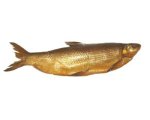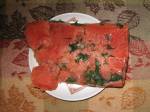Bagels, lox, and cream cheese was part of my childhood food experience. As essential as matzoh ball soup, lox (smoked salmon) was part of Jewish cultural life. To this very day, I cannot go very long without a bagel and cream cheese with a little lox on top. Sometimes I would accessorize with a slice of red onion, some cucumber slices, a little tomato, or some fresh dlll. When real bagels were unobtainable, I would debase myself by purchasing faux bagels like those you find in supermarkets or Panera’s. Lox is a bit harder to find. Most supermarket brands are poor substitutes. Sam’s Club carries a decent brand of Nova lox but it is still not the same as lox you would find in expensive delis in east and west coast cities. Therefore my search for the perfect bagel with lox and cream cheese has been a lifelong ambition. So I decided to find a way to make my own lox. And I did.
My childhood food experiences included frequent weekend trips to the deli with my father to buy traditional Jewish breakfast treats. My dad would purchase a little belly lox and a little Nova Scotia lox. Belly lox was cheaper than Nova. It was brined in water, salt, sugar and spices and was too salty for me. My mother would soak the belly lox in water to decrease the saltiness and would usually use it in scrambled eggs. Nova lox was cured in a mild brine, usually oil based, and was called ‘Nova Scotia’ simply because the salmon sold in New York at the time came from Nova Scotia. I did not realize as a child that lox was not a Jewish food but actually a Scandinavian food hungrily devoured by Jewish immigrants like my grandparents from Eastern Europe.
My father would also buy a couple of whitefish, a tub of herring, some smoked sable, and a little bit of smoked sturgeon. To this day, I have not eaten smoked fish as good as these were. But then again I do not live on the east coast where for you can still buy these tasty delicacies if you are willing to spend $25.00 to $45.00 per pound that is, not including shipping.
I did not know that there are several varieties of lox. Scottish salmon is dry brined; Nordic salmon is salt cured and cold smoked; and Gravlax is cured with salt, sugar, and dill or juniper berries. As a child, I did not realize that lox was a fish. The only salmon I ever had was salmon croquettes that my mother made from canned salmon. However turnabout is fair so when I ask for lox at local midwestern restaurants that have smoked salmon on the menu, the wait staff has no idea what I am talking about.
I did not eat fresh salmon until I was an adult. It quickly became my favorite fish as well as the favorite of my fish hating youngest daughter. She was sold on it when we were in Seattle and she had salmon jerky. After that all things salmon became her desire.
Over the years I have collected dozens of salmon recipe variations; poached, broiled, pan-fried, microwaved, grilled,and so on, but not a single recipe for raw salmon. I had no idea that you could make a lox variant at home until I discover Gravlax in Ireland.
The discovery that there were many variations of cured salmon was a revelation. I was already skilled at making smoked salmon on the grill. My favorite was a recipe in one of Steven Raichlen‘s barbeque books for rum soaked salmon. I use the same basic technique to make salmon jerky. But I did not know that I could also cold cure raw salmon at home until I discovered Gravlax. Called ‘gravad lax’ in Sweden, ‘gravlaks‘ in Norway and Denmark, ‘graavilh‘ in Finland, ‘graavilohe‘ in Estonia, and ‘Graflax‘ in Iceland, gravlax is raw salmon cured with salt, sugar and dill. It is siced very thin and usualy served with a dill mustard sauce and bread. Like lox, gravlax is not smoked. Gravlax literally means ‘grave salmon’. Hundreds of years ago, salted salmon was buried in the sand (grav means ‘grave’ or ‘to dig’) and allowed to ferment. ‘Laks’ or ‘lax” means salmon.
I first tasted gravlax in Ireland and decided to find out more about this raw lox-like salmon. I made a point in Sweden, Norway, and Denmark to try gravlax as often as I could. I also searched the web for recipes. I was concerned at first when I learned that one had to be careful in selecting salmon because of the possibility that salmon could contain parasitic roundworms. The recommendations were to only use commercially frozen salmon to insure that any parasites are killed. No fresh salmon.
After thinking it over for almost a year, I made a first attempt at gravlax. Unfortunately I used a cheap salmon fillet from China. It didn’t look good after curing so I baked it instead. The next time I bought a premium salmon side. It turned out perfectly. Spend the money for a better fish. It will be worth it. Some methods for making gravlax have you weigh down the salmon with a brick, others have you splash the salmon with vodka. Neither is really necessary. Other recipes overdo the use of salt, sugar, and dill. You do not want to overcure the fish. Less is actually more in this case. One recipe I found recommended using more dill than my herb garden could possibly provide in two years. You don’t need very much dill at all. But you do need to use fresh dill, not dried dill.
There are a variety of techniques available on the internet for making gravlax. These are my two favorites.
[Gravlax on Cooking For engineers]
[Best Gravlax recipe on the Internet]
During a recent trip to Minneapolis, my wife and on went to the IKEA store on impulse. We had intended to visit it when in Stockholm but never got around to it. Although I was astonished by the simplicity of the IKEA designs and immediately wanted to do a total house make-over, I was blown away when I discovered the IKEA restaurant/cafe. It served gravlax, shrimp sandwiches, and swedish meatballs. Of course I had to sample it all. Mmmmmm! [IKEA Cafe]









 Posted by wyona
Posted by wyona